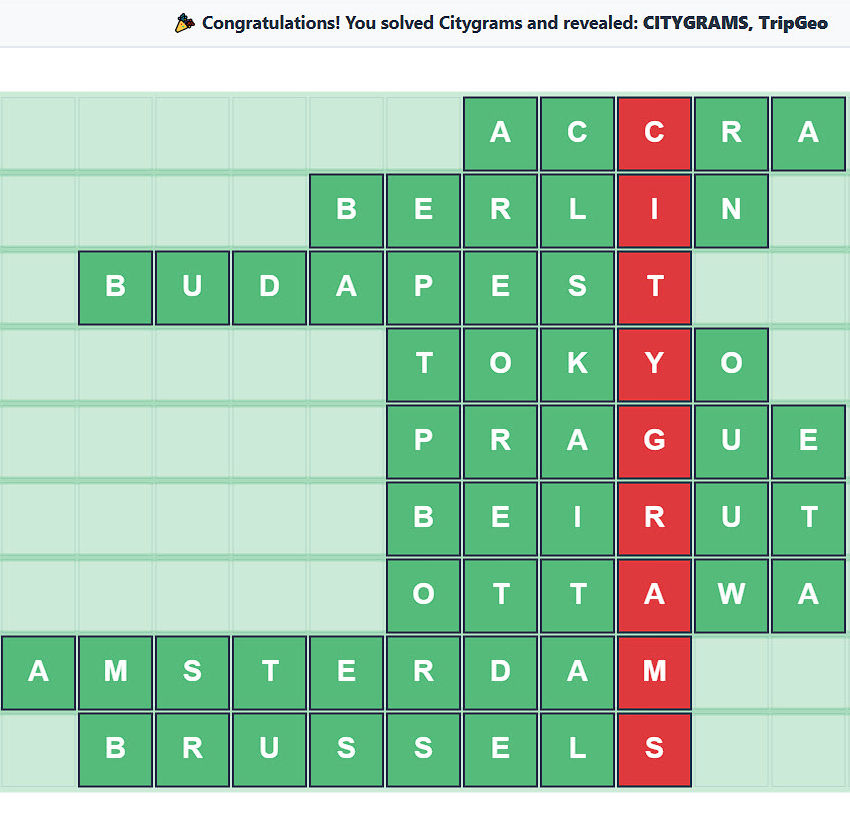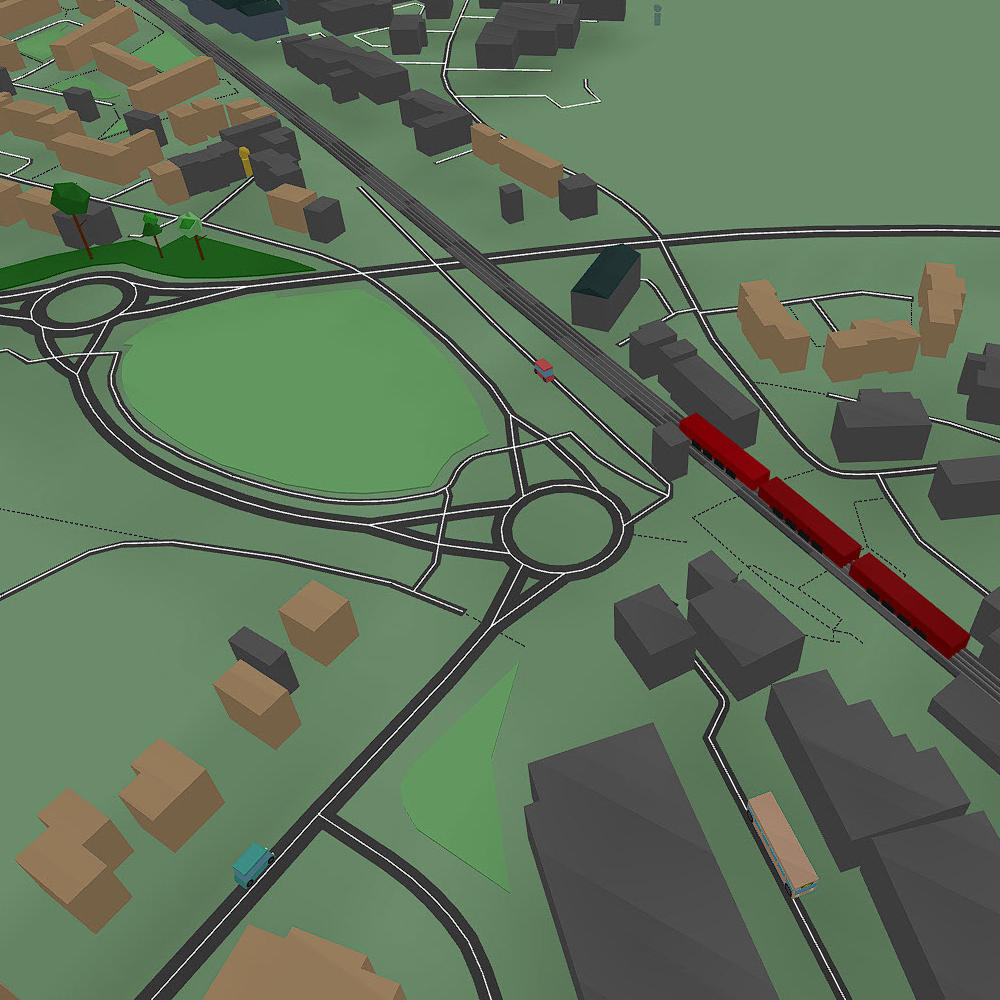A Tale of Two City Games
In the world of geography-based gaming, two of my recent projects represent very different approaches to engaging with cities and locations around the globe. Whilst both share a common fascination with urban spaces and geographical knowledge, they occupy distinctly different positions on the spectrum from prototype to polished product.
Citygrams: The Complete Experience
Citygrams is a fully-realised daily puzzle game that combines geography knowledge with wordplay in an innovative two-stage challenge. Players begin by solving anagrams of city names, dragging and dropping letter tiles to unscramble famous locations from around the world. Once all the anagrams are solved, the real puzzle begins: arranging the rows of cities to spell out a hidden word vertically in one of the columns.
The game offers three difficulty levels - Easy Mode featuring 4-5 capital cities with 4-6 letters each, Hard Mode presenting 6-7 cities with up to 10 letters each, and Special themed puzzles focusing on cities from specific countries or regions. Like Wordle, the puzzles change daily, encouraging regular engagement whilst building geographical knowledge.
What sets Citygrams apart is its seamless integration with the broader TripGeo ecosystem. The cities featured in each puzzle are directly linked to the TripGeo city guide, allowing players to explore detailed information about the locations they've just unscrambled. Notably, Citygrams deliberately avoids maps, instead focusing purely on the linguistic and spatial challenge of working with city names as textual puzzles.
Trip City: The Experimental Sandbox
Trip City represents the other end of the development spectrum - a 3D sandbox prototype that transforms any location in the world into an interactive virtual environment. Built using Three.js and Open Street Map data (without relying on traditional Maps APIs), Trip City generates realistic layouts complete with buildings, roads, railways, parks and fields.
The magic of Trip City lies in its animation system. Animated citizens walk the streets, cars navigate the road network, buses follow their routes, and trains run along railway lines. Trees populate parks and gardens, whilst agricultural fields change colour over time, creating a sense of seasons passing. The result is a 'lived-in' city that feels genuinely alive.
Users can create their own Trip City for virtually any location worldwide. The system works best for villages, small towns, or focused sections of larger cities, as extensive areas can impact animation performance. It's a fascinating proof of concept that demonstrates the potential for creating dynamic, animated representations of real-world geography.
Comparing the Two Approaches
The contrast between these projects is striking. Citygrams represents the culmination of focused development - a complete game with clear objectives, daily content updates, multiple difficulty levels, and tight integration with existing TripGeo features. It's a product that users can engage with immediately and return to regularly.
Trip City, by contrast, embodies the exploratory spirit of prototyping. It's a technological experiment that pushes boundaries, demonstrating what's possible when combining mapping data with 3D graphics and animation. Whilst it lacks the structured gameplay elements of Citygrams, it offers something perhaps more valuable: a glimpse into the future of interactive geographical experiences.
Both projects share a commitment to making geography more engaging and accessible. Citygrams achieves this through educational gameplay that builds knowledge whilst entertaining. Trip City does so by transforming static map data into dynamic, living environments that invite exploration and wonder.
The Broader TripGeo Gaming Ecosystem
These two projects exist within a rich ecosystem of geographical games and tools. The TripGeo platform hosts numerous other experiences including Tube Recall (the London Underground naming game), Backdrop (visual geography challenges), Map Memory (unlabelled map identification), GeoTripper (efficient routing between cities), and many others including the innovative Scrambled Maps series.
Each game brings its own approach to geographical education and entertainment, from historical timeline challenges in 1000 Years to the visual puzzle-solving of Jumbled Maps. The diversity demonstrates that there are countless ways to engage with geographical knowledge, whether through word puzzles, visual challenges, routing problems, or immersive 3D environments.
Looking Forward
Citygrams shows the value of taking a concept through to completion - creating a polished, daily-updated experience that can build a dedicated audience. Trip City represents the importance of experimentation and pushing technological boundaries, even when the end goal isn't immediately clear.
Trip City may well evolve into a more complete gaming experience in future iterations. The foundation is certainly there for various gameplay mechanics - from navigation challenges to city-building elements to collaborative multiplayer experiences. For now, it serves as an impressive demonstration of what's possible when real-world geographical data meets modern web technologies.
To see video introductions to many of these TripGeo games in action, visit the Videos page where you can explore visual walkthroughs and discover which experiences might appeal to your particular interests in geography and gaming.
Both Citygrams and Trip City demonstrate that geographical gaming continues to evolve, whether through refined puzzle mechanics or experimental technological approaches. The tale of these two city games is ultimately a story about different paths to the same destination: making our world more engaging, one location at a time.
More Posts
- Introducing Stories: AI-Powered Visual Narratives on TripGeo
December 23, 2025 - GeoGallery: Where Art Meets Geography
December 22, 2025 - 🗺️ Introducing Country Recall!
December 15, 2025 - 🔷🎯🔶Tank of Duty: Neon Tank Combat Meets Modern Web Technology 💥💥💥
December 5, 2025 - Scramble! Command RAF Fighters in Our Battle of Britain Game
November 12, 2025 - 🎮 Introducing GeoBox - Your New Multiplayer Gaming Experience 🌍
October 24, 2025 - Curb Value: The Ultimate House Price Guessing Game
October 10, 2025 - Multiplayer Battleships: A Classic Naval Battle in Your Browser
October 1, 2025 - Introducing Tube Recall – Tripgeo’s Ultimate London Underground Challenge!
July 25, 2025 - View the Tour de France 2025 with animated street view
July 12, 2025 - TripGeo on YouTube - Introducing Our New Videos Page
June 30, 2025 - Introducing the New TripGeo Cities Directory
May 14, 2025 - From London Streets to Maps in the Wild: TripGeo's New Scrambled Maps Collection Series
May 2, 2025 - Hunt for Hidden Eggs & Discover the Mysterious Easter Creature!
April 10, 2025 - Play 1000 Years!
April 4, 2025 - Introducing Vintage Scrambled Maps Challenge
April 2, 2025 - Scrambled Maps: Create and Challenge!
March 25, 2025 - Soar and Explore: TripGeo's Air Tours and Travel Cat Take Virtual Travel to New Heights
March 3, 2025 - Scrambled World: Scrambled Maps Goes Global!
February 20, 2025 - Jumbled Maps: A New Challenge for Geography Enthusiasts
February 6, 2025 - Street View Animator: Transforming Virtual Exploration
February 1, 2025 - Discover the United States Like Never Before with TripGeo’s New Geography Map Game!
January 5, 2025 - Welcome to TripGeo: Your Portal for Interactive Maps and Geography Games
January 1, 2025

